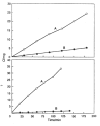Mathematical modeling of molecular diffusion through mucus
- PMID: 19135488
- PMCID: PMC2646819
- DOI: 10.1016/j.addr.2008.09.006
Mathematical modeling of molecular diffusion through mucus
Abstract
The rate of molecular transport through the mucus gel can be an important determinant of efficacy for therapeutic agents delivered by oral, intranasal, intravaginal/rectal, and intraocular routes. Transport through mucus can be described by mathematical models based on principles of physical chemistry and known characteristics of the mucus gel, its constituents, and of the drug itself. In this paper, we review mathematical models of molecular diffusion in mucus, as well as the techniques commonly used to measure diffusion of solutes in the mucus gel, mucus gel mimics, and mucosal epithelia.
Figures












Similar articles
-
Technological strategies to estimate and control diffusive passage times through the mucus barrier in mucosal drug delivery.Adv Drug Deliv Rev. 2018 Jan 15;124:64-81. doi: 10.1016/j.addr.2017.12.002. Epub 2017 Dec 12. Adv Drug Deliv Rev. 2018. PMID: 29246855 Free PMC article. Review.
-
Drug transfer through mucus.Adv Drug Deliv Rev. 2001 Jun 11;48(2-3):173-93. doi: 10.1016/s0169-409x(01)00115-6. Adv Drug Deliv Rev. 2001. PMID: 11369081 Review.
-
[Mucus models for investigation of intestinal absorption mechanisms. 2. Mechanisms of drug interactions with intestinal mucus].Pharmazie. 1992 Aug;47(8):609-13. Pharmazie. 1992. PMID: 1438513 German.
-
[Mucus models for investigation of intestinal absorption mechanisms. 4. Comparison of mucus models with absorption models in vivo and in situ for prediction of intestinal drug absorption].Pharmazie. 1992 Oct;47(10):787-91. Pharmazie. 1992. PMID: 1480659 German.
-
A study of macromolecular diffusion through native porcine mucus.Experientia. 1992 Jan 15;48(1):22-6. doi: 10.1007/BF01923598. Experientia. 1992. PMID: 1737572
Cited by
-
A Microscopically Motivated Model for Particle Penetration into Swollen Biological Networks.Polymers (Basel). 2020 Aug 25;12(9):1912. doi: 10.3390/polym12091912. Polymers (Basel). 2020. PMID: 32854259 Free PMC article.
-
Mimicking microbial strategies for the design of mucus-permeating nanoparticles for oral immunization.Eur J Pharm Biopharm. 2015 Oct;96:454-63. doi: 10.1016/j.ejpb.2015.01.010. Epub 2015 Jan 20. Eur J Pharm Biopharm. 2015. PMID: 25615880 Free PMC article. Review.
-
Nanoparticle-mediated drug delivery to treat infections in the female reproductive tract: evaluation of experimental systems and the potential for mathematical modeling.Int J Nanomedicine. 2018 May 3;13:2709-2727. doi: 10.2147/IJN.S160044. eCollection 2018. Int J Nanomedicine. 2018. PMID: 29760551 Free PMC article. Review.
-
Physicochemical properties of mucus and their impact on transmucosal drug delivery.Int J Pharm. 2017 Oct 30;532(1):555-572. doi: 10.1016/j.ijpharm.2017.09.018. Epub 2017 Sep 14. Int J Pharm. 2017. PMID: 28917986 Free PMC article. Review.
-
Mucus models to evaluate the diffusion of drugs and particles.Adv Drug Deliv Rev. 2018 Jan 15;124:34-49. doi: 10.1016/j.addr.2017.11.001. Epub 2017 Nov 5. Adv Drug Deliv Rev. 2018. PMID: 29117512 Free PMC article. Review.
References
-
- Creeth JM. Constituents of mucus and their separation. Br Med Bull. 1978;34:17–24. - PubMed
-
- Norris DA, Puri N, Sinko PJ. The effect of physical barriers and properties on the oral absorption of particulates. Adv Drug Deliv Rev. 1998;34:135–154. - PubMed
-
- Lee SP, Nicholls JF. Diffusion of charged ions in mucus gel: effect of net charge. Biorheology. 1987;24:565–9. - PubMed
-
- Khanvilkar K, Donovan MD, Flanagan DR. Drug transfer through mucus. Adv Drug Deliv Rev. 2001;48:173–93. - PubMed
-
- Allen A, Leonard AJ, Sellers LA. The mucus barrier. Its role in gastroduodenal mucosal protection. J Clin Gastroenterol. 1988;10 1:S93–8. - PubMed
Publication types
MeSH terms
Substances
Grants and funding
LinkOut - more resources
Full Text Sources
Other Literature Sources

